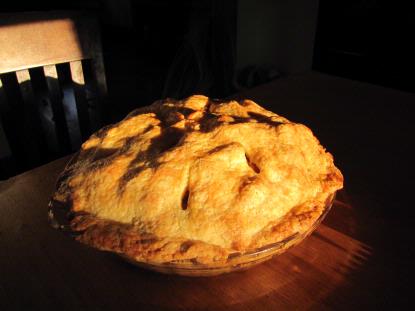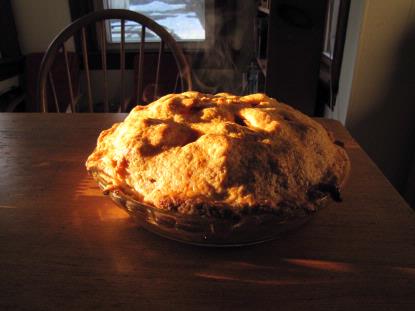The boss is on something of a pie bender. She’s made an apple pie and a fantastic blueberry pie in the last few weeks. Apparently the eldest boarder mentioned something about liking pie and this set her off. He doesn’t like very many foods. But pie, really, you’ve got to try pretty hard to not like pie. It was clever on his part. If he’d said “gee ma (he doesn’t call her boss for some reason), I sure do like ice cream” I somehow doubt she would have been pounding out rocky road all weekend.

My boss is not one to shirk a challenge. When she makes pie, she makes her own crust and she uses butter. As I’m sure you are aware keeping the butter cold helps to ensure that the crust is flaky. She goes to great lengths to ensure that the butter stays cold. I offered to turn the heat down significantly, but was rebuffed. When a pie crust goes into the oven the cold little clumps of butter melt quickly and some of the water turns to steam, this makes little pockets in the dough and gives a lovely flakey crust.
I realized this while watching the boss make her confection. Don’t worry, I was working too. I was, uh, grooming the cat. In any case, the obsession with cold is to keep that butter from melting. Butter fully melts at about body temperature 98.6 F. To get a flakier dough a fat with a slightly higher melting temp can be useful. This is why some people really like vegetable shortening which has a melting point north of 115 F. Unfortunately it tastes like industrial grease. Lard has a variable melting point, but Suet, like vegetable shortening is around 115 F.
So Suet it is. Oddly, the only brand of Suet I could find for sale is Atora. As I see it, this is an anagram for Aorta, and Suet, a fully saturated fat is not good for your Aorta. But I digress.
The melting point of these fats is determined by their chemical properties. Fats are essentially long chains of carbon atoms bonded to one another: the longer the chain, the higher the melting point. They also have a few hydrogen atoms attached to the carbons: more hydrogens means more saturated and a higher melting point. Saturated fats (like lard and butter) have high melting points. Unsaturated fats (like olive oil) have low melting points.

had another big fat experience this weekend, this time with a chemist related in a paternal-type way to the boss. He was making polenta by order of the uber-boss. He tried frying it in olive oil and it was a no go – the polenta just didn’t form nice cakes. He switched to shortening and they turned nice and golden. Fats have different smoke points that limit how much you can heat them. This in turn depends on how refined they are and the fatty acid chains – just as with the melting point. Extra virgin olive oil has a smoke point around 320 F – about 100 degrees hotter than boiling water. Vegetable shortening is about 360, so it’s better for frying. Of course there are other oils with even higher smoke points peanut is 450 and refined avocado is as much as 500 F. Suet starts smoking at about 400 and lard at just 374. Once again, let’s hear it for the plants.


